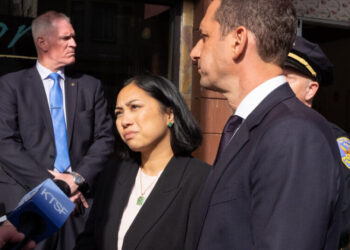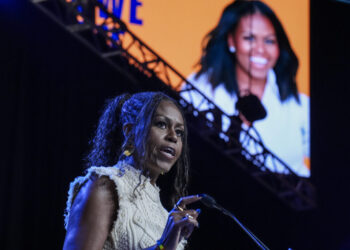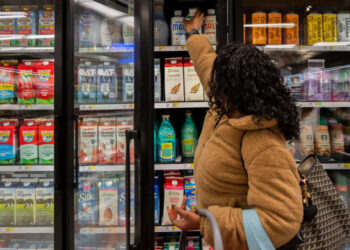More than a decade ago, Tinder became the hottest dating app, transforming modern romance by making it possible for singles to swipe through people’s profiles, match and meet up.
Now, Tinder is fighting to keep the flame alive. Sometimes in unexpected ways.
Last month, it convinced UCLA students to meet in a big group in the real world. They danced together as 26-year-old DJ Disco Lines played a set at the Fowler Museum on campus.
Instead of spending time swiping, students swayed on the dance floor under disco balls, holding up their smartphones as they listened to Disco Lines’ hot remix of Tinashe’s song “No Broke Boys” — a track about setting high standards in romantic relationships.
The West Hollywood company had partnered with the DJ and college influencers who posted videos with that song on TikTok and Instagram to promote the event and the app. Ahead of the show, Tinder also encouraged people on social media to download the app to find the event’s location and time.
“Swipe right. Swipe right. Swipe right,” Disco Lines said in the videos as he mimicked the motion.
Young daters today want more from dating apps than an opportunity to swipe, said Mark Kantor, Tinder’s head of product.
“Gen Z wants to connect authentically. They believe in romance. They’re open to serendipity,” he said. “They’re hopeful, but they want to go beyond just the photo experience.”
Tinder is attempting to woo Gen Z users with in-person events and new features after the number of people who pay for and regularly use the service has dropped.
In the third quarter of this year, Tinder had 9.2 million paying users, a 7% decline from the same period last year. Tinder’s revenue dropped 3% to $491 million. The app has a free version, but people pay for extra features, including the ability to see who likes their profile or to temporarily increase their profile’s visibility so they can get more matches.
Although it is still the world’s most popular dating app, it has lost users recently in major markets. Its monthly active user tally in the U.S. is around 11 million this quarter, down from 18 million in early 2022, according to market intelligence firm Sensor Tower.
The company has a new leadership team — including new chief executive, Spencer Rascoff, who started in July — that is betting the app can find its second wind by developing new features. Rascoff is also the chief executive of Tinder’s parent company Match Group.
Some of Tinder’s new releases include double date and college mode, where students can meet others at their university or nearby colleges. The company is testing a new AI-powered feature called “Chemistry,” in which people give Tinder permission to analyze their camera roll to learn more about their interests and personality. It started requiring that users in several countries take video selfies to verify they’re real and match their profile pictures.
Tinder’s goal: to reinvent dating again.
“Dating has become this thing that, for many people, has felt like work and meeting people really needs to be fun,” said Kantor.
Launched in 2012 at the University of Southern California, Tinder changed the way people date by making it simple to browse through dating profiles filled with photos on their smartphones and match with people nearby. The company’s co-founder Sean Rad, a USC dropout, presented the idea for a dating app, originally called Matchbox, at a startup incubator’s hackathon.
Online dating used to involve filling out a lengthy questionnaire and responding to matches on a computer. On Tinder, people just swipe right if they’re interested and left if they’re not.
Many people flocked to the app as a convenient way to find casual sex. As it took over the dating world, a lot of users now have a love-hate relationship with Tinder. Some only turn it on when they are lonely, others struggle with the constant rejection that comes with not matching on the app. Some even blame Tinder for the dawn of the “dating apocalypse,” the decline of romance and an environment where people are reluctant to commit as they cling to hope that the perfect match might be a swipe away.
“It needs to cater a little bit towards a female audience, or make it more friendly,” said Sam Nejad, a 27-year-old California actor and contestant on the reality TV show “The Bachelorette.” “For guys, specifically, from my experience, it’s purely a smashing app.”
Tired of swiping through hundreds of profiles, filled with gym selfies, thirst traps, scammers and men holding fish, some daters have turned elsewhere to find love, in places such as running clubs, events, train rides, Home Depot and even Costco.
That fatigue has also spawned Tinder competitors.
Sick of coffee dates with people she met on dating apps, Cassidy Davis asked her friends in 2022 to invite one person off an app for a Valentine’s Day party in her Los Angeles apartment. A TikTok video about the event went viral. Since then, she’s hosted “chaotic singles parties” monthly in different venues in Los Angeles, San Francisco and elsewhere.
“The apps are still really useful, but a lot of people these days are looking for that rom-com, IRL meet-cute,” said Davis.
The 31-year-old is now engaged to a man whom she invited to her first chaotic singles party. The couple met earlier in real life, and not through a dating app.
She said she might not have matched with him if she had seen him online.
“I don’t think his profile would have translated to the awesome person he is today,” she said.
The dating landscape is crowded. Startups are creating AI companions and other apps that claim to do a better job of matching people. Then there are other popular dating apps such as Bumble, Hinge and Grindr. Social media giant Facebook has a dating service too.
It’s often difficult for giant industry leaders to change the way their brand is perceived.
“We really haven’t seen a large number of names, at least within the online dating space, try and then succeed at these turnarounds in the past,” said Morgan Stanley analyst Nathan Feather.
Still, Tinder’s new chief executive says his company is developing new products to stay on top.
A Harvard graduate who grew up in Los Angeles and New York, Rascoff teaches and talks to students on college campuses, learning about what Gen Z wants from online dating. His father was a business manager and tour producer for famous musicians, including The Rolling Stones and U2. His mom was a real estate agent.
Before starting well-known companies, he worked as an investment banker and private equity investor. At one point, Rascoff wanted to become a journalist. He was the editor-in-chief of the paper at Harvard-Westlake, a college preparatory school in Los Angeles County, and interned at major news outlets but had a bigger interest in business, according to a 2020 interview with the C-Suite Quarterly.
Match Group, whose share price once reached more than $169 per share in 2021, has seen its stock tumble to below $30 in 2023 as investors saw Tinder’s paying user numbers drop. In the last six months, Match Group’s stock has been up 12% to more than $32 per share, a sign that investor confidence is growing.
Tinder does have a competitive edge. It’s widely used and often the first app people turn to when they want to start dating again. Despite its reputation as a hookup app, Tinder says it’s meant for people to find the relationship they want, whether it’s an open relationship, love or new friends on their terms.
Match Group estimates there are roughly 250 million single people worldwide who are actively dating but are not on dating apps, Rascoff said in a call with analysts in November.
“We’ve clarified what Tinder stands for and who we’re building it for,” he said.
UCLA student Sharlize True Trujillo, 21, got paid to promote Tinder’s event with Disco Lines to her nearly 3 million followers on TikTok. She attended and enjoyed mingling with the crowd, but said online dating isn’t going away any time soon.
“My friends and I would prefer to meet someone in person,” she said. “But at this time, we meet way more people that are our type online.”
The post People are dumping Tinder. The dating app wants to reignite its spark by getting singles offline appeared first on Los Angeles Times.




